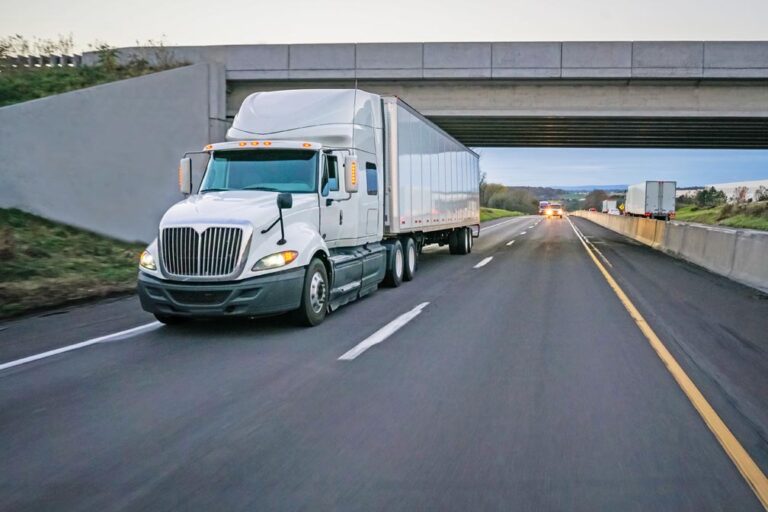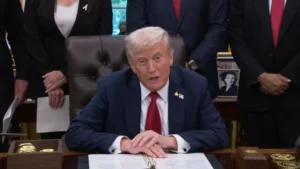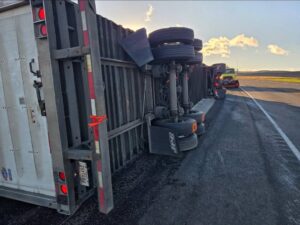WASHINGTON — Citing the importance the trucking industry plays in the American economy, the Biden Administration on Thursday rolled out the Truck Action Plan, pledging help during one of the most challenging times ever for the nation’s supply chain.
“Trucking plays a critical role in the U.S. supply chain and economy,” a White House news release stated.
“America’s truck drivers have been on the frontlines of this pandemic, delivering goods to every corner of this country. Seventy-two percent of goods in America are shipped by truck, and in most communities, trucks are the only form of delivery. A strong, stable, and safe trucking workforce that offers good-paying jobs to millions of truck drivers is a critical lifeblood of our economy. But outdated infrastructure, the COVID-19 pandemic, and a historic volume of goods moving through our economy have strained capacity across the supply chain, including in trucking.”
Steps the president and his team said will be immediately taken are:
- Reducing barriers to drivers getting CDLs;
- Introducing a 90-day challenge is a national effort to recruit employers interested in developing new registered apprenticeship programs and expanding existing programs to help put more well-trained drivers on the road in good trucking jobs;
- Conducting veterans-focused outreach and recruitment; and
- Supporting drivers and ensuring that trucking jobs are good jobs is foundational for a strong, safe, and stable trucking workforce.
Expanded details about these measures are explained later in this article.
In the next 30 days, the White House is pledging that:
- The Department of Labor (DOL) and Department of Transportation (DOT) will kick off listening sessions with drivers, industry and labor leaders, along with advocates, to hear their perspectives, profile promising practices and source scalable solutions to retention and job quality issues for truckers. The first events in this series are happening today in South Carolina with Transportation Secretary Pete Buttigieg, Deputy Administrator Meera Joshi and representatives from DOL and at the White House co-chaired by Buttigieg, Labor Secretary Marty Walsh and National Economic Council Director Deese.
- The Federal Motor Carrier Safety Administration (FMCSA) will issue funding opportunities for states to streamline CDL processing and reduce testing delays.
- The DOL, DOT and intermediary partners will work closely with committed trucking employers to launch the first group of apprenticeship challenge programs.
- The FMCSA and DOL will begin an in-depth study of driver compensation, as part of the Bipartisan Infrastructure Law, to examine truck driver pay, including the time drivers spend waiting to pick up or drop off freight without getting paid.
- The DOL’s VETS and the Department of Veteran Affairs will organize a meeting with Veterans Service Organizations and Military Service Organizations to discuss opportunities to employ veterans in the trucking industry, including leveraging Veteran Affairs’ education and training benefits.
In the next 60 days, the White House is pledging:
- Acknowledging that safety is the highest priority for truck drivers, FMCSA will launch a pilot for drivers ages 18-21 as mandated by the Bipartisan Infrastructure Law, incorporating Registered Apprenticeships to ensure rigorous training standards and pairing each young driver with an experienced mentor. This would allow drivers under 21 to haul freight across the nation.
- DOL and DOT will host a series of national Apprenticeship Accelerator meetings to help more firms develop new programs and release a quick-start toolkit for apprenticeships in the trucking sector.
- DOL’s Veterans’ Employment and Training Service (VETS), DOL Employment and Training Administration and DOT’s FMCSA will conduct a roundtable to discuss efforts to facilitate a CDL for transitioning service members and veterans. The meeting will include representatives from the United Services Military Apprenticeship Program as well as Veterans Affairs.
- In 2021, VETS initiated and implemented Employment Navigator and Partnership Pilot (ENPP) to more effectively assist transitioning service members with the establishment of career goals and to connect them with best-in-class employment partners to facilitate positive employment outcomes. ENPP is currently at 16 military installations. DOL will expand the Employment Navigator and Partnership Pilot (ENPP) program to now include the trucking industry.
And during the next 90 days:
- The Department of Labor will announce the results of the 90-day Apprenticeship Challenge and announce new partnerships to continue to expand apprenticeships in the trucking industry.
- DOT and DOL will launch the task force dedicated to promoting the recruitment, inclusion and advancement of women in trucking established in the Bipartisan Infrastructure Law. This task force will be the first of many strategies to help build the pipeline and diversify the trucking workforce.
- DOT and DOL will launch the task force to investigate predatory truck leasing arrangements that dissuade drivers from entering or staying in the industry established in the Bipartisan Infrastructure Law.
- DOT and DOL will deliver a comprehensive action plan, informed by its series of listening sessions, outlining any further administrative and regulatory actions the Administration can take to support quality trucking jobs.
The Truck Action Plan is part of the Biden-Harris Administration’s Supply Chain Disruptions Task Force, launched in June to address near-term supply chain bottlenecks as the economy rapidly reopened following the Administration’s historic vaccination and economic relief efforts.
The task Force is co-chaired by the secretaries of commerce, transportation and agriculture to lead a whole of government effort to address these disruptions.
The task force has been convening stakeholders to diagnose problems and surface solutions—large and small, public or private—that will help alleviate bottlenecks and supply constraints, in order to minimize the impacts on workers, consumers and businesses, and bolster a strong economic recovery.
The news release noted that the pandemic exacerbated longstanding workforce challenges in the trucking industry, including high turnover rates, an aging workforce, long hours away from home, and time spent waiting–often unpaid–to load and unload at congested ports, warehouses and distribution centers.
According to one estimate, long-haul full-truckload drivers only spend an average of 6.5 hours per working day driving despite being allowed to drive a maximum of 11 hours.
That means about 40 percent of their capacity is not being used. Many truckers also bear the burden of gas, insurance and maintenance costs, which reduces their take home pay, creating significant challenges in recruiting and retaining drivers with the right credentials and experience into today’s trucking jobs. At the same time, the industry reports historic demand for its services. Reflecting that demand, wages for employed drivers in all trucking segments have increased 7-12% in the last year alone, but employment in some segments is still below pre-pandemic levels.
“The administration is taking action, and now we are asking industry, labor and all levels of government to partner with us to address these trucking workforce challenges and begin building a next generation trucking workforce,” the White House news release stated.
“A stronger trucking workforce is one where trucking jobs are good, safe and stable — jobs that employers can attract a new generation of drivers into while retaining existing drivers to deliver for clients and grow their businesses. The nation’s trucking workforce also demands clear, debt-free paths into these good jobs through high-quality training, such as Registered Apprenticeships, which prepare trainees and provide employers with a steady pipeline of skilled, safe and experienced drivers.”
IMMEDIATE ACTIONS EXPLAINED
Take steps to reduce barriers to drivers getting CDLs: DOT and the FMCSA are supporting state departments of motor vehicles as they return to—or even exceed—pre-pandemic commercial driver’s license (CDL) issuance rates, which is helping bring more truck drivers into the field. FMCSA will provide over $30 million in funding to help states expedite CDLs.
On Thursday, the FMCSA sent all 50 states a toolkit detailing specific actions they can take to expedite licensing and will work hand-in-hand with states to address challenges they are facing. FMCSA will also begin closely tracking delays, identifying states that have challenges with issuing CDLs and communicating with all 50 governors about ways they can reduce delays in issuing CDLs.
In 2021, on average, more than 50,000 CDLs and Learners Permits have been issued each month, which is 20% higher than the 2019 monthly average and 72% higher than the 2020 monthly average.
In fact, by the end of October 2021, states had issued more licenses and permits than in all of 2019. While backlogs and delays exist in some States, they can be cleared by using proven strategies. For example, using these tools this past summer, New York reduced testing delays by 37%.
California recently expanded hours and locations and increased the number of personnel who can administer the road test. North Carolina increased the availability of testing appointments, and Texas has expanded hours, testing capacity and shifted much of the process online.
“There is more work to do, and FMCSA is using the levers of government to make it easier for truck drivers to get their CDLs, while also taking actions to address retention issues,” the news release stated.
Kick off a 90-day Challenge to accelerate the expansion of Registered Apprenticeships: This 90-day challenge is a national effort to recruit employers interested in developing new Registered Apprenticeship programs and expanding existing programs to help put more well-trained drivers on the road in good trucking jobs. Trucking employers of all sizes and across industry segments——from long haul to last mile, from cargo containers fresh off of ships to tank trucks transporting essential fuel – are seeing the potential value of Registered Apprenticeship. Registered Apprenticeship is the gold-standard of workforce training that provides paid, on-the-job learning, and today there are more than 10,000 apprentices in the trucking industry.
Expanding this proven workforce strategy in trucking is critical for ensuring high-quality training for new drivers and helping employers develop and retain a skilled and safe workforce. For employers ready to step up, DOL and national partners will help accelerate new program development in as little as two days. To kick off the Challenge, DOL is announcing today:
FASTPORT, a DOL-funded national apprenticeship intermediary partner with a focus on the transportation sector, is committing to work with trucking employers, unions, and industry associations to establish Registered Apprenticeship programs for their organizations in as little as 48 hours.
DOL’s Office of Apprenticeship’s (OA) consultants located across the country will be available to assist organizations interested in starting a new program or joining an existing program. OA launched a 90 Day Apprenticeship Trucking Challenge website for interested employers, unions and intermediaries to express their interest in developing Registered Apprenticeship programs to meet their workforce needs.
DOL is investing $8 million in more national apprenticeship intermediaries who can help employers start registered apprenticeships in trucking and other supply chain industries.
EVO Trucking, D.M. Bowman, Yellow Corporation, Florida Rock and Tank, Total Transportation and CRST are committing to launch, expand and work with our Administration on a Registered Apprenticeship through our Accelerator.
The White House said it will be working with the Trucking Alliance and the American Trucking Associations, who will help engage their members on the value of a Registered Apprenticeship to support quality, safety and retention.
Conduct veterans-focused outreach & recruitment: There are approximately 70,000 veterans who are likely to have certified trucking experience in the last five years. The DOL Veterans’ Employment and Training Service (VETS) and the Department of Veterans Affairs (VA) will work with Veterans Service Organizations, Military Service Organizations, unions, industry trucking associations, training providers and private partners to enable transitioning service members and veterans to attain good jobs in the trucking industry. DOL and VA will work to ensure veterans’ driving experience is recognized for those seeking a CDL and will build on proven models, such as SkillBridge programs for transitioning service members.
This includes:
- Expanding outreach with partners and stakeholders in the veteran employment space to support veteran career pathways into the trucking industry.
- Helping employers seeking CDL drivers connect with federal, state and other resources to facilitate connecting those employers to job-seeking veterans.
- Expanding partnerships between the Employment Navigator and Partnership Pilot (ENPP) to the trucking industry to more effectively assist transitioning service members with the establishment of career goals and to connect them with best-in-class employment partners to facilitate positive employment outcomes.
- Exploring use of the Off-Base Transition Training Pilot Program (OBTT) to extend employment readiness curriculum to connect veterans, National Guard and Reserve members and their spouses to a career path in trucking.
- Amplify VA programs that provide truck driving and related training to include the Veteran Readiness & Employment (VR&E) program and the Veteran Rapid Retraining Assistance Program (VRRAP). VA currently offers 120 approved commercial driving programs to veterans eligible for the VRRAP program, of which 31 are currently being used. More than 8,400 commercial driving programs are approved for use by eligible veterans under the GI Bill.
Launch joint DOT- DOL Driving Good Jobs initiative: Supporting drivers and ensuring that trucking jobs are good jobs is foundational for a strong, safe and stable trucking workforce. DOT and DOL are announcing today the launch of the joint Driving Good Jobs initiative, which marks a new partnership between the agencies that will include: hosting listening sessions that engage drivers, unions and worker centers, industry and advocates; lifting up employers and best practices that support job quality and driver retention that can be scaled; working together to implement research and engagement efforts outlined in the Bipartisan Infrastructure Law, including studying the issue of truck driver pay and unpaid detention time; identifying effective and safe strategies to get new entrants in the field from underrepresented communities, including women and young drivers between the ages of 18-20; setting up a task force to investigate predatory truck leasing arrangements; and identifying longer term actions, such as potential administrative or regulatory actions that support drivers and driver retention by improving the quality of trucking jobs.
The Trucker News Staff produces engaging content for not only TheTrucker.com, but also The Trucker Newspaper, which has been serving the trucking industry for more than 30 years. With a focus on drivers, the Trucker News Staff aims to provide relevant, objective content pertaining to the trucking segment of the transportation industry. The Trucker News Staff is based in Little Rock, Arkansas.
















One step that would go a long way to keeping freight moving is eliminating the 70-hour clock requiring a 34-hour restart. Just let us run 14 hour days, 11 hours driving, so we don’t run out of hours at the end of our run when we are trying to make it home for some R&R. That would allow drivers to choose how long they want to stay out and let them continue to move freight, and earn their pay, everyday instead of having to sit for a silly restart.
Yes and that 30 minute brake is a joke! The majority of drivers use it to fuel, something they already do every day. At best it’s just slowing down the fuel island.
The last thing the trucking industry needs are 18 yr olds driving 80,000 lbs at 70 mph. If they are not considered responsible enough to buy alcohol, they are not responsible enough to make split second, life saving decisions behind the wheel of a semi.
Great feedback buddy. I have 42 years driving OTR and I see too many new jackass driving and texting like as a car. We will see too many accident and fatalities as these inconsiderate asses coming in the road.
Amen. I would add, could someone tell me just one thing the government ever got involved in that didn’t become FUBAR?
You damn right! The government is just a bunch of jackass talking out of the side of their neck. When the 18 to 21 find out they can’t go home every night or weekend to get their booty call, their trucks will be abandoned in truck stop, and they are on the first bus going home lol . They still don’t get it ELD is the BIG problem.
As a new driver although I’m 56, I can say I don’t think there is nearly enough training to taking the wheel of an 80000# beast. CDL Schools are only focused on getting you to your CDL. No real training on handling the truck at freeway speeds. I spent the last 2 weeks driving around the South and it scares the hell out of me how many drivers text and drive. Lowering the bar will get people killed. I feel the rest of it falls on the company hiring the driver. My company already covers most of what’s discussed in their action plan, and a final note. I agree with the fact that anything the government touches turns to crap.
Yup…just MORE ammo for the government to blame the truckers for everything…except when they need toilet paper !!!!
How about federal subsidies to states to provide more parking the parking is horrendous 11 to 12 trucks for every spot or worse it is the hardest thing at the end of the day or night to find parking legal parking
I’m a longtime driver at 27 years over the road. I say Instead of getting kids into trucks they need to compensate and entice experienced drivers to stay on the roads. Besides all those idiots in government have never been in a truck the closest they’ve been to one is being passed by a truck on the highway. They should ask us what we need out here to make our jobs easier.
Amen. But like being passed by a truck, they never take the time to get to know us or what we do. Instead they put cotton in their ears and create new rules and laws designed by the desires of lobbyists, cubicle office workers, and politicians steeped in graph and corruption. And when it is pointed out, they say we are uneducated rubes, defending old fashioned ideologies that only destroy the environment and are based on prejudice and racism.
Sadly they fail to see that their intentions are more inclined to put chains on us and keep us enslaved and beholden to Massa Big Government. A pox on Biden!
Parking is definitely a huge issue for drivers. I understand why stores like Walmart don’t want us parking in their lots but that also limits drivers on the food choices we have if we are limited to over priced truck stops. For all we sacrifice we don’t make enough money especially when sitting for hours to get loaded and unloaded at facilities. 18-21 year olds have no business driving these trucks and I’m not sure the insurance companies for the trucking industry will go for this. We put up with a lot of crap and still most of us love driving these trucks and take pride in what we do. The white house has no business getting involved on this level. I’ve been driving for over 21 years and there is a reason truck drivers are held to such a high standard. If we lower the bar people die.
Put 50 instructors in a well funded think tank for 30 days and watch our trucking industry get completely rebuilt.
So “Truck Driver Joe” wants to help truckers? My first suggestion would be admit the election was stolen. My second suggestion would be for him to immediately rescind his destructive attack on our oil industry, the most successful protection of our borders. And most importantly the restoration of the IRS exemptions that provided all drivers relief from the exorbitantly high costs of food and supplies we have to purchase while on the road. I was told that a per diem was given to our companies to offset this loss to drivers. What a joke! Even a lousy fast food junk meal easily costs $10.00. In an inflationary setting caused by the political class choosing a path to socialism and the loss of freedoms once considered sacred to Americans, nothing can be expected but the destruction of our industry. In nearly 30 years of driving, I see little in the way of real improvements provided by fools like him and his wretched ilk. I expect only more of the same. Tyranny and bandage.
As for reading this long passage passed out by his supporters, I prefer not to waste my time. I already had enough wind this week in the Midwest.